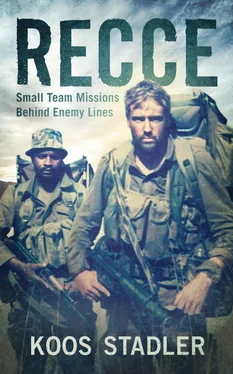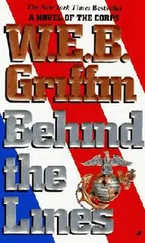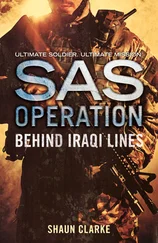Then Dave Drew gave us an overview of how SWAPO received its logistics. Supplies went mainly by train from the port of Namibe via a distribution base at Lubango, then to the operational front headquarters, and eventually by truck to the detachments on the ground. He zoomed in on the area between Lubango and Namibe, describing the topography and vegetation of the semidesert terrain, and finally highlighting the railway line, the types of trains that were used and the frequency of the log runs.
Since Diedies would be on a course during our preparations for Killarney I was appointed mission commander, while Oom Boet would be the Tac HQ commander.
“The cover story for the deployment is that you will be going on a Small Team training exercise to Sawong,” Eric McNelly said, “which will actually be the case. You will spend two weeks at Sawong for rehearsals, and then move to Pretoria for the second stage of the rehearsals as well as final planning and briefings.”
Rehearsals at Sawong followed the usual pattern of exercises to condition our minds and bodies for night work. We would use the hours of darkness to practise team drills and rehearse every contingency. Much time was spent on patrol tactics, anti-tracking and emergency procedures. In the early morning, after a full night’s work, we’d do a strenuous PT session, carrying our buddy or running with backpacks. After catching a few hours’ sleep in the morning, we’d brush up on first aid, often administering drips to ourselves. During daylight hours we honed our communications skills, concentrating on sending and receiving Morse code. During the hottest part of the day we worked on recognition of enemy weapon systems.
After two weeks of intensive preparation, we departed for Pretoria. I went in my own car since I wanted to spend time with Zelda before the deployment. Although I had battled with my feelings for her for a long time, our relationship soon grew into much more than a friendship. Whenever I was in Pretoria on business, I stayed with Zelda and her family in the affluent Waterkloof Ridge neighbourhood. We were very fond of each other and had wonderful times together, but soon the secrecy of my job and the uncertainty of our long-term deployments started to affect our relationship.
Hiding the true nature of our forthcoming deployment introduced some complications, since by then Zelda had some grasp of Special Forces and the type of operations we were involved in. Since she had met Diedies and some of my comrades, she was part of the “inner circle” of Small Teams and had a fairly good understanding of our job. As far as our families were concerned, I would be doing one of the regular long-term stints on the border, as was common during that time.
After the weekend with Zelda I moved back to the Karos Hotel in Pretoria, where we stayed at reduced rates when the officers’ messes were full. Our rehearsals now became more focused, as we needed to master the technicalities of railway demolitions. Specialists from EMLC taught us the intricacies of working with a mine, code-named Pick, tailor-made for diesel-electric trains. To ensure that the charge would not detonate when an empty carriage was coupled to the front of a train, Pick was designed to activate only once a diesel-electric locomotive passed over it. The device could be programmed to remain in sleep mode for up to three months, and then to arm itself and wait for the approach of a diesel-electric unit. The device had a little antenna that would pick up the electromagnetic field generated by the electric motor (the diesel engine in a diesel-electric unit is primarily there to generate power for the electric motor that drives the train), thus activating the mechanism. It was also fitted with an anti-lifting device that would react to any disturbance of the mine.
The explosives used for trains, code-named Slurry, consisted of an RDX base washed out of PE4, then mixed with nitro-methane to form liquid explosives. Aluminium powder was added for incendiary effect. The advantage of Slurry, which we carried in thickly sealed plastic bags, was that it could be poured into a hole made in the ballast of the train tracks. It would trickle down into the open spaces and fill all the cavities among the ballast. When exposed to air Slurry would eventually settle and slowly turn into a solid. The complete charge, Pick and Slurry , would be positioned to derail the train and cause maximum damage to the diesel-electric unit.
Various other devices, some extremely advanced for their time, were invented by EMLC and tailor-made for operations. Working on a similar basis as Pick, a device called Shovel was designed for vehicles, while the charge accompanying it was Hydra, a robust explosive that could be formed into all kinds of shapes – even resembling elephant dung strewn on the road surface! Another device I would get to know intimately was the mechanism used for demolishing aircraft, called Tiller, and its specially designed charge, Havoc, consisting of the explosive Torpex based on a solid aluminium plate for incendiary effect.
We visited train shunting yards and various stretches of track to get a grasp of the new challenge. It was important for us to understand the impact explosives had when placed in different positions on the track. I learned that, due to its sheer weight, a train could not be derailed simply by an explosion under the belly of a unit or a coach. The rail itself had to be disrupted, while factors such as the curve of the line, the speed of the train and the height of the tracks above ground level had to be taken into account.
By that time we had invented a new technique to prepare the railway site and plant the device: Diedies and Neves had designed a small tent that could be assembled and positioned over the tracks within a few seconds. With the side flaps stuck together with Velcro, the tent was completely light-tight. The operator inside the tent would use a powerful headlamp, allowing him to work fast and effectively and to make sure that, once the hole between the tracks had been filled in and the site covered up, the camouflaging would pass close scrutiny.
One problem was that the top layer of the track ballast, through exposure to the elements, had a different colour and texture from the underlying stones. The operator therefore had to clear the top layer and keep these stones aside to cover the hole again once the job was done. Previously, operators had used night-vision goggles when replacing the ballast, but the unnatural green image created by the goggles often meant that some discolouration would be visible on the surface. Working with white light reduced the risk of poor camouflage, and it certainly boosted the operator’s confidence when connecting and arming the detonating device.
One Saturday night, while I was staying at Zelda’s parents for the weekend, we had a rehearsal on a disused railway line passing through a deserted stretch of land outside Pretoria. Da Costa, Neves, Vic and I spent the Saturday at Special Forces HQ preparing for the night’s work, and departed for the target area as soon as it was dark. Since it was not meant to be a tactical exercise, two of the EMLC technicians joined us to provide technical support and advise us on the placement of the devices.
We got started straight away, but soon realised that digging into the ballast would not be an easy job. Until late that night we worked on various ways to remove the stones and dig into the strata below, testing different types of tools for the job and practising different ways of inserting the devices. At about 02:00 we packed up, satisfied with the night’s work, and started towards the parked vehicles.
We had to cross a dilapidated old fence line and, since my arms were full of equipment, two of the guys held the rusted strands down to help me get across. Then, unexpectedly, a single strand snapped loose and ripped across my face, one of the wire knots tearing open my upper lip, strangely enough on the inside, as I must have had my mouth open at that moment. In an instant blood was spurting all over the place. The operators rushed me to 1 Military Hospital, where the wound was stitched up. A heavy dose of painkillers and antibiotics rounded off the treatment.
Читать дальше












